The Terror of a New Cold War
There can be no winner in a nuclear conflict, and the refusal of the United States to negotiate with Russia increases the likelihood of such a cataclysm.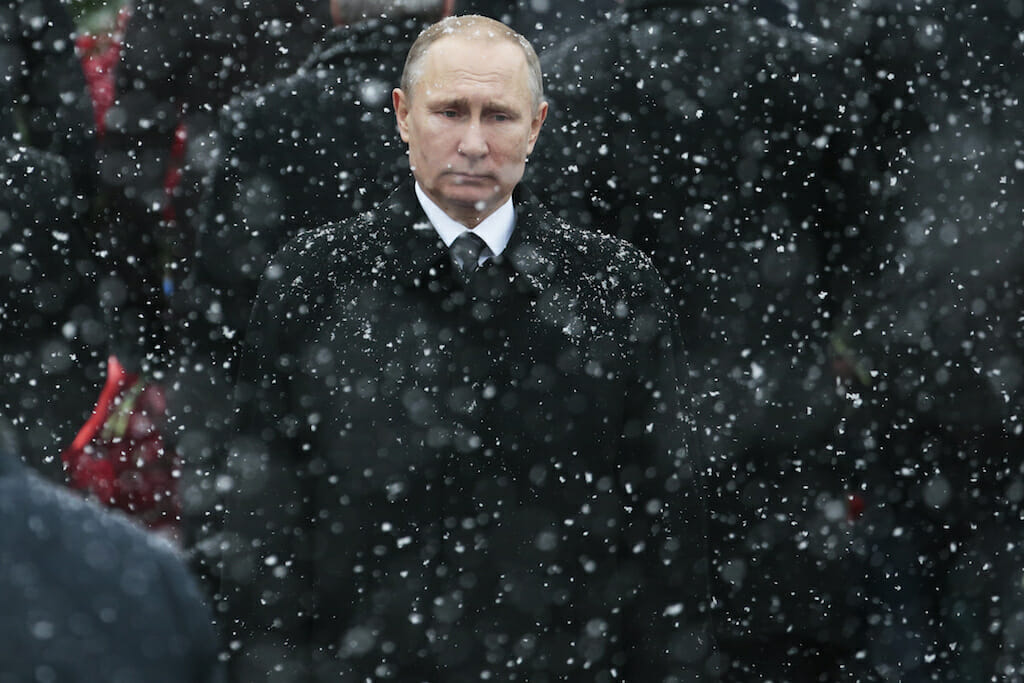 Russian President Vladimir Putin attends a wreath-laying ceremony at the Tomb of the Unknown Soldier in Moscow in 2017. (Ivan Sekretarev / AP)
Russian President Vladimir Putin attends a wreath-laying ceremony at the Tomb of the Unknown Soldier in Moscow in 2017. (Ivan Sekretarev / AP)
On March 1, in his annual state of the nation speech to the Russian Federal Assembly, President Vladimir Putin declared that his country has developed an “invincible” intercontinental cruise missile resistant to US missile defense systems. Putin claimed the new weapon can operate at very high speeds and has unlimited range.
Although “some experts” have suggested Putin may be bluffing, Theodore A. Postol, professor emeritus of science, technology and national security policy at MIT, told Truthout, “I think he’s deadly serious.” Postol, who evaluated Moscow’s anti-ballistic missile defense while serving as adviser to the chief of naval operations in the early 1980s, said Putin’s speech “made very clear that every attempt to engage us in constructive discussion has been met with no response. He was responding to the US unwillingness to talk about missile defenses.”
U.S. Withdrawal From Treaty Escalated the Arms Race
Putin criticized George W. Bush’s 2002 withdrawal from the 1972 Anti-Ballistic Missile (ABM) Treaty, which stated that in order to reduce offensive nuclear forces in Russia and the United States, both sides would have to agree to limit anti-ballistic missile defenses.
“Russia was categorically against [the U.S. withdrawal],” Putin said. “We saw the Soviet-US ABM Treaty signed in 1972 as the cornerstone of the international security system.”
The significance of the US withdrawal from the ABM treaty cannot be overestimated, in Postol’s opinion. “What the Russians would say, and I fully agree, is that the current escalating arms race between the United States and Russia is a direct product of US withdrawal from the ABM treaty of 1972,” he said.
As David Krieger, founder of the Nuclear Age Peace Foundation, noted at Truthdig, “The fuel for a new nuclear arms race was already on the fire, and a Russian strategic response was predictable, when the US withdrew from the ABM Treaty and began developing and emplacing missile defense systems globally. The US withdrawal and abrogation of the ABM Treaty may prove to be the greatest strategic blunder of the nuclear age.”
Likewise, Moscow correspondent Fred Weir wrote in the Christian Science Monitor, “The US withdrew unilaterally from the 1972 Anti-Ballistic Missile Treaty … triggering Russian fears that technological advances might one day wipe out their nuclear deterrent.”
“Things have been escalating for quite a while,” Postol pointed out, adding that the U.S. is “increasing the size of its missile defenses while at the same time trying to get Russia to reduce the size of its offensive forces.” That “created a theoretical imbalance. The US has been building, in theory, a system that could be used to intercept Russian forces while those forces are being reduced.”
The escalation of the nuclear arms race continued during the Obama administration. As Reuters reporter Scot Paltrow has pointed out, “By the time Obama left office in January 2017, the risk of Armageddon hadn’t receded. Instead, Washington was well along in a modernization program that is making nearly all of its nuclear weapons more accurate and deadly.” Paltrow cited examples of lethal nuclear weapons developed on Obama’s watch.
Does Missile Defense Really Work?
Postol is skeptical about the effectiveness of missile defense systems because they have only been tested under the “most orchestrated conditions and even under those conditions, they have failed a high percentage of the time, some simply because something unexpected happened. In combat, the conditions will not be choreographed.”
Thomas S. Lee, writing for CNN, agrees that anti-ballistic missile defense systems are ineffective. Lee noted, “It is very hard to shoot down a ballistic missile. This is true even of a short-range ballistic missile with a relatively flat trajectory, much less a long-range missile with many more possible trajectories and a far greater speed.”
But Donald Trump thinks US missile defenses can be very effective, Postol observed. “In a crisis or a standoff, Trump might take actions he wouldn’t take if he thought he was defenseless. So, the potential for miscalculation is much higher when the weapons systems are not effective.”
Former Defense Secretary William Perry described the dangers of nuclear miscalculation, citing a 1983 incident in which Russian satellite nuclear warning systems mistakenly thought they detected five U.S. nuclear missiles launched at Russia, as well as the Cuban Missile Crisis.
Trump’s New Policy Increases Possibility of Nuclear Weapons Use
Other signs indicate that Trump is very open to nuclear weapons use. His administration’s new Nuclear Posture Review reveals “a shift from one where the use of nuclear weapons is possible to one where the use of nuclear weapons is likely,” Beatrice Fihn, executive director of the International Campaign to Abolish Nuclear Weapons (ICAN), said in a statement.
Putin alluded to the Nuclear Posture Review (NPR) in his speech, noting, “Some of the provisions of the updated US nuclear strategy review, which reduces the threshold for using nuclear weapons, trigger tremendous concern. It is written in such a way that it can be used in response to a conventional weapon strike or even in response to a cyberthreat.”
This is not an exaggeration. For the first time, Trump’s NPR would allow the United States to use nuclear weapons in response to non-nuclear attacks, including cyberattacks, in “extreme circumstances to defend the vital interests of the United States, its allies and partners.”
The war in Syria, in which both the U.S. and Russia are already involved, may provide a venue for just that eventuality. Former U.N. weapons inspector Scott Ritter wrote on Truthdig, “It doesn’t take a stretch of imagination today to paint a scenario in which American and Russian forces clash over Syria.”
“Putin’s statement makes it clear we are in a new arms race that will put us under the terror of a new Cold War, in constant fear of death at any instant,” Fihn added.
However, Postol asserted, “The United States has created the appearance that it believes it can fight and win a nuclear war against Russia.” That’s a false assumption, he said. “After nuclear weapons are used by one side, or when they are used preemptively, the other side would mount a massive attack against central strategic forces of the attacking state.”
There is no winning a nuclear war, even a limited one, as Geoff Wilson at the Ploughshares Fund wrote in The National Interest. “The reality is that planning to use nuclear weapons in a ‘limited’ way is a dangerous fantasy,” he noted. “Even the Nixon administration paid lip service to the futility of the concept by referring to its plan for limited nuclear strikes against the Soviet Union as the ‘Madman Theory.’ “
That doesn’t even account for the incalculable devastation a nuclear explosion, or series of nuclear explosions, would wreak on the environment.
Make no mistake. The nuclear arms dealers stand to profit handily from the heightened nuclear arms race. In their recent report, ICAN and PAX, a nongovernmental peace organization, concluded that the top 10 financial institutions with the greatest investment in manufacture of nuclear weapons are U.S. companies, which account for almost half ($253 billion) of the total investment.
As Bush pulled out of the Anti-Ballistic Missile Treaty, he escalated the “global war on terror.” But, in January, Defense Secretary James Mattis stated that “great power competition, not terrorism, is now the primary focus of US national security.”
Ritter writes on Truthdig that Putin’s speech was a message not just to the Russian Federal Assembly, but also to the White House and Trump, as well as Congress, “where Russia-baiting has become a full-time occupation, and to the American people, who have been caught up in a wave of anti-Russia hysteria fueled by fantastical claims of a Russian ‘attack’ on American democracy which, when balanced against the potential of thermonuclear annihilation, pales into insignificance.”
Thomas Graham, senior director for Russia on George W. Bush’s National Security Council, thinks we are in a very dangerous period. Graham told The Washington Post, “The tension is high, higher now than it was several months ago, in part because the Russians have gotten past the phase where they thought with President Trump they would be able to move the relationship in a different direction. … This is qualitatively worse than any post-Cold War period.”
Treaty on the Prohibition of Nuclear Weapons Leads to Divestment
On July 7, 2017, more than 120 countries adopted the UN Treaty on the Prohibition of Nuclear Weapons. It forbids ratifying countries “never under any circumstances to develop, test, produce, manufacture, otherwise acquire, possess or stockpile nuclear weapons or other nuclear explosive devices.” The treaty also prohibits the transfer of, use of, or threat to use nuclear weapons or nuclear explosive devices.
Fifty-three countries signed the treaty, and three have ratified it, making them parties to the agreement. The treaty will enter into force 90 days after 50 ratifications. But the five original nuclear-armed nations—the U.S., Britain, France, Russia and China—did not participate in the treaty negotiations and have not signed it.
The treaty, however, “has created a movement towards divestment, reflected in the reduction in the number of companies investing in nuclear weapons, and an increase in financial institutions comprehensively prohibiting any investment,” according to Susi Snyder of PAX, who is a co-author of the new report. “Investments are not neutral, these companies should be congratulated for standing on the side of humanity.”
Meanwhile, in response to Putin’s March 1 invitation to enter into nuclear arms negotiations for “international security and sustainable development,” Krieger wrote, “The U.S. should take him up on this offer.”
Indeed, we should. The future of our planet is at stake.
Copyright, Truthout.org. Reprinted with permission.
Your support matters…Independent journalism is under threat and overshadowed by heavily funded mainstream media.
You can help level the playing field. Become a member.
Your tax-deductible contribution keeps us digging beneath the headlines to give you thought-provoking, investigative reporting and analysis that unearths what's really happening- without compromise.
Give today to support our courageous, independent journalists.
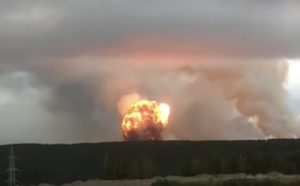
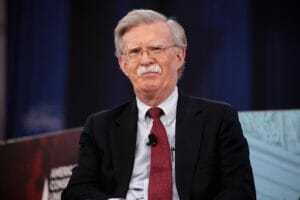
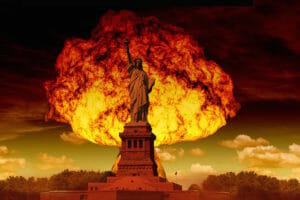
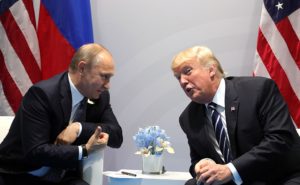


You need to be a supporter to comment.
There are currently no responses to this article.
Be the first to respond.